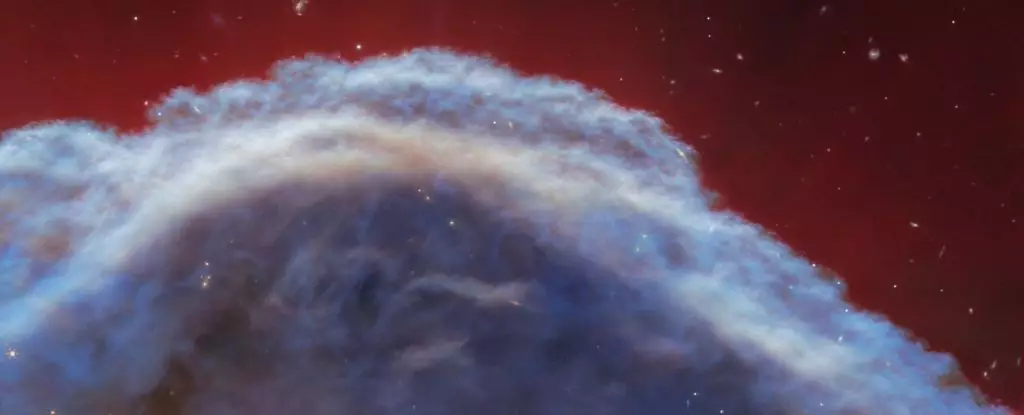Recent mid- and near-infrared observations from the James Webb Space Telescope have provided a groundbreaking look at the iconic space cloud known as the Horsehead Nebula. In a remarkable high-resolution image, the telescope captured intricate details atop the ‘horse’s head, revealing tendrils and filaments that had never been seen before. Using a combination of 23 filters, a team of astronomers achieved an unprecedented level of resolution, allowing them to track emissions from particles as small as 20 nanometers across. This included the detection of interstellar polycyclic aromatic hydrocarbons, scattered light from larger grains, and ionized hydrogen within the nebula.
The Horsehead Nebula, named for its resemblance to a horse’s head, is located approximately 1,300 light-years away as part of the Orion molecular cloud complex. This dense cloud is teeming with dust and gas, appearing as dark shadows in optical light. However, when viewed up close or in wavelengths outside the visible spectrum, the nebula transforms into a luminous, billowing structure. Unlike many other celestial bodies, the Horsehead Nebula lacks an internal source of light. Instead, it is primarily heated by the nearby Sigma Orionis complex, a system of young, hot stars radiating at temperatures of around 34,600 Kelvin.
The Horsehead Nebula serves as an invaluable laboratory for studying stellar nurseries due to its distinctive characteristics. The ‘horse’s head’ itself is a dense clump of material that has collapsed under gravity, harboring young stars in the process of formation that are obscured by the surrounding dust. Despite its darkness, the nebula is heavily influenced by the intense radiation from the nearby stars in the Sigma Orionis complex. This radiation triggers a process known as photodissociation, where molecules are broken apart by ultraviolet light, leading to the formation of a neutral interstellar medium.
The newly obtained observations from the James Webb Space Telescope offer a deeper understanding of the Horsehead Nebula and its surrounding environment. By analyzing the small-scale structures along the illuminated edge of the nebula, scientists have identified a network of filaments perpendicular to the photodissociation region. These filaments consist of dust and gas that contribute to the photoevaporative flow process within the nebula. The next phase of research will involve a comprehensive analysis of the emitted light to unveil the chemical composition of the dust and gas, as well as determine the size and flow of dust grains based on light scattering.
Through detailed modeling, researchers aim to unravel the evolution of dust within the photodissociation region of the Horsehead Nebula. By studying how these clouds change and evaporate over time, valuable insights can be gained into the formation and evolution of newborn stars that lie hidden within the dense material. The combination of infrared observations and advanced analysis techniques promises to shed new light on the mysteries of stellar nurseries and the intricate processes shaping our cosmic neighborhood.


Leave a Reply